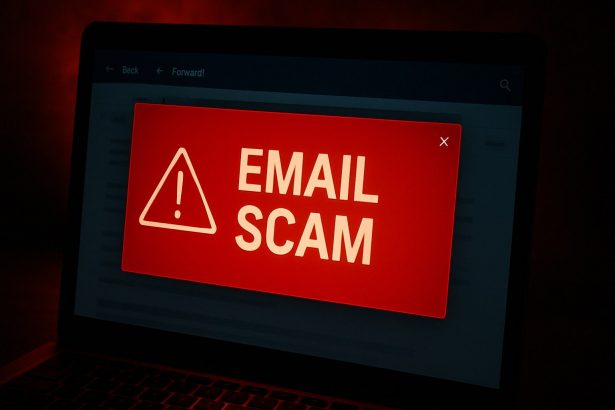The “Renew Your Webmail Access” email scam is a phishing attempt designed to steal your email login credentials by posing as a legitimate system notification. It pretends to be a routine service update, warning that your webmail access is about to expire unless you act immediately. The goal? To trick you into clicking a fake renewal link that leads to a fraudulent login page. This scam is part of a wider wave of credential-harvesting campaigns targeting both personal and business email accounts. If you’ve received this message, don’t panic—but don’t ignore it either.
Threat Overview
| Threat Type | Phishing / Email Scam |
|---|---|
| Associated Email | Varies – typically spoofed or fake |
| Detection Names | Phishing.Email, Scam.Webmail, Email.Scam.RenewAccess |
| Symptoms | Fake expiration notice, credential theft attempt |
| Damage & Distribution | Account compromise, identity theft, spam campaigns |
| Danger Level | High – leads to full email takeover |
| Removal Tool | SpyHunter |
How “Renew Your Webmail Access” Tricks Users
The scam arrives in your inbox disguised as a legitimate notice from your webmail provider. It claims that your account access is about to expire or that you’re running an outdated version of your email service. To keep your access, the message urges you to click a button labeled something like “RENEW MY ACCOUNT NOW.”
This is a classic phishing attempt. The button redirects you to a fake login page designed to look like your real email provider. If you enter your credentials there, attackers instantly gain access to your inbox — and potentially to your entire digital life.
Full Text of the “Renew Your Webmail Access” Message
The content of the scam email can vary slightly, but it generally looks like this:
Subject: Final Reminder: Renew Your Webmail Access
Body:
You are currently using the old version of your Webmail. Failure to upgrade will result in permanent account closure.
Click the button below to renew your Webmail access:
[RENEW MY ACCOUNT NOW]
Thank you,
Webmail Admin
The message may use a fake company name or impersonate your real email provider. Most versions also contain spelling or formatting errors, though some may appear convincingly professional.
What Happens If You Fall for the “Renew Your Webmail Access” Scam
If you enter your email login credentials into the phishing site, attackers will immediately have access to your account. From there, they can:
- Send spam or additional scams from your account
- Reset passwords for other services linked to your email
- Steal sensitive personal data or documents
- Launch targeted attacks against your contacts
- Commit identity theft or financial fraud
Even if no immediate damage occurs, your email account will likely be sold on the dark web.
How to Manually Identify and Remove Email Scams
Manually removing email scams involves recognizing fraudulent messages, securing your accounts, and taking precautions to prevent future attacks. Follow these steps:
Step 1: Identify Suspicious Emails
Before taking action, you need to identify scam emails. Common signs include:
- Unknown Sender: Emails from unfamiliar addresses, especially if they claim to be from banks, tech support, or government agencies.
- Urgency or Threats: Scammers often pressure you to act immediately (e.g., “Your account will be closed in 24 hours!”).
- Poor Grammar & Spelling: Many scam emails contain obvious grammatical mistakes.
- Suspicious Links & Attachments: Hover over links (without clicking) to check the actual URL. If it looks odd, don’t click.
- Requests for Personal Information: Legitimate companies will never ask for passwords, Social Security numbers, or credit card details via email.
Step 2: Do Not Click Links or Download Attachments
If you suspect an email is a scam:
- Do not click on any links.
- Do not open any attachments.
- Do not reply to the sender.
Step 3: Report the Email Scam
You can report the scam email to various authorities:
- Gmail/Outlook/Yahoo Users: Click the “Report Phishing” or “Report Spam” button in your email client.
- FTC (Federal Trade Commission, USA): Report to FTC Complaint Assistant.
- Google Safe Browsing: If the scam email contains a phishing website, report it here.
Step 4: Block the Sender
- Gmail: Open the email, click the three dots in the top-right corner, and select “Block [Sender Name]”.
- Outlook: Open the email, select “Junk” > “Block Sender”.
- Yahoo Mail: Open the email, click “More” > “Block Sender”.
Step 5: Check Your Accounts for Unauthorized Activity
If you accidentally clicked a link or shared sensitive information:
- Change your passwords immediately. Use strong, unique passwords for every account.
- Enable two-factor authentication (2FA). This adds an extra layer of security to your accounts.
- Check your banking statements for unauthorized transactions.
Step 6: Scan Your Device for Malware
Some email scams contain malware hidden in attachments or malicious links. Run a full system scan using built-in tools:
- Windows Defender (Windows 10/11):
- Go to Settings > Update & Security > Windows Security > Virus & Threat Protection.
- Click “Quick Scan” or “Full Scan”.
- Mac Users:
- Use Malwarebytes for Mac or another security tool.
Step 7: Adjust Your Email Security Settings
- Enable email filtering to reduce spam and phishing emails.
- Add a third-party spam filter such as Mailwasher or Spamihilator.
- Educate yourself and others on phishing techniques to avoid future scams.
How to Remove Email Scams Using SpyHunter (Automated Method)
For users who prefer an automated, foolproof method to remove threats linked to email scams, SpyHunter offers an advanced security solution. SpyHunter is an anti-malware tool designed to detect and remove phishing-related threats, spyware, Trojans, and other cyber threats. Follow these steps:
Step 1: Download SpyHunter
- Visit the official SpyHunter download page: Download SpyHunter
- Click on “Download” and save the installation file to your computer.
Step 2: Install SpyHunter
- Locate the downloaded file (SpyHunter-Installer.exe) and double-click to open it.
- Follow the on-screen installation instructions.
- After installation, launch SpyHunter.
Step 3: Perform a Full System Scan
- Open SpyHunter and navigate to “Malware/PC Scan”.
- Click “Start Scan Now” to begin a deep scan of your system.
- SpyHunter will analyze files, registry entries, and processes for any threats linked to email scams, phishing, and malware.
Step 4: Review and Remove Detected Threats
- Once the scan completes, SpyHunter will list all detected threats.
- Click "Fix Threats" to remove them.
- Restart your computer to complete the removal process.
Step 5: Enable Real-Time Protection
SpyHunter includes real-time protection features to help prevent future infections:
- Enable Active Guards: This monitors your system for malware in real time.
- Schedule Automatic Scans: Set up periodic scans to detect new threats early.
Step 6: Keep SpyHunter Updated
- Regularly check for updates to ensure SpyHunter detects the latest threats.
- To update SpyHunter, open the app and go to "Settings" > "Update", then click "Check for Updates".
Preventing Future Email Scams
Now that you've removed email scams, take proactive steps to prevent them in the future:
Use a Secure Email Provider
- Consider switching to a secure email provider like ProtonMail or Tutanota, which offer advanced encryption.
Be Cautious with Email Links
- If you receive an email with a suspicious link, verify the website’s legitimacy before clicking.
Avoid Public Wi-Fi for Sensitive Activities
- Scammers can use public Wi-Fi to intercept your data. Use a VPN when accessing email on public networks.
Regularly Change Your Passwords
- Update your passwords every few months, and never reuse old passwords.
Use Anti-Phishing Extensions
- Install browser extensions like Bitdefender TrafficLight or Avast Online Security to detect phishing links in real-time.
Email scams are a serious cyber threat that can lead to financial loss, identity theft, or malware infections. By following the manual removal steps, you can effectively identify and remove suspicious emails on your own. However, for advanced protection, using SpyHunter ensures a more thorough and automated approach to detecting and removing phishing-related threats.
Recommended Action
For a fast and efficient way to remove email scams and related malware, download and install SpyHunter now: Download SpyHunter
By staying informed and proactive, you can protect yourself from future email scams and online threats!
Conclusion
The “Renew Your Webmail Access” scam is a high-risk phishing campaign that preys on urgency and fear. It doesn’t matter which email provider you use — anyone can be a target. If you received this message, delete it immediately and never click any links.
If you already clicked and entered your information, take action right away. Change your password, enable 2FA, and monitor your accounts closely for suspicious activity.




